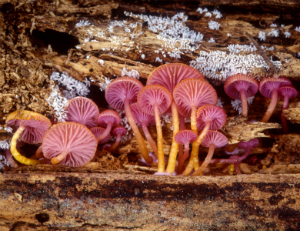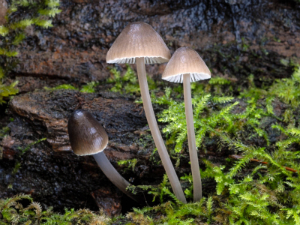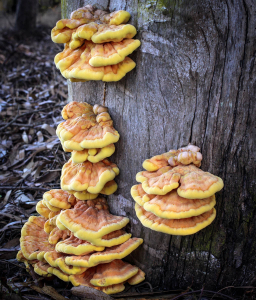All caps: Experts publish guide to California mushrooms
When Dennis Desjardin’s grandparents emigrated to California in the 1920s, they were delighted to find a taste of the old country among the Sitka-spruce forests of their new home. Mushrooms that looked like the chanterelles of their native Switzerland grew near their Crescent City farm.

Chromosera cyanophylla (photo by M.G. Wood)
“When I was 3, they were taking me out into the woods to collect mushrooms, the chanterelles, the porcinis, the meadow mushrooms,” the professor of biology recalled, “but also telling me that everything else out there was poisonous and I shouldn’t touch them.”
The warning didn’t scare off the inquisitive young Desjardin, who took a few career detours -- musician, house builder -- before he became a world-class mycologist at SF State. This fall, he and photographers Michael Wood and Frederick Stevens share their advice on finding a few more fungal favorites in California Mushrooms: The Comprehensive Identification Guide, due out in November from Timber Press.
Inside, mushroom hunters will find keys to identifying 650 species of mushrooms, with more than 750 color photos, identification keys and information about toxicity and habitats. For those who want to dig deeper into mushroom biology, the guide also provides a glimpse at the microscopic structures that help define each species.
The book covers some of the more than 3,000 species of mushrooms in California, where the fungi are found in forests and deserts, and also in parking lot mulch. California Mushrooms took two years to complete, with Desjardin doing most of the writing and Wood and Stevens selecting the accompanying images from tens of thousands of photographs.

Mycena abramsii (photo by B.A. Perry)
The large color photos and identification keys make the guide stand apart from others that offer only a short description of each species. “We wanted something a little bit more in-depth, a little bit more informative, and then add as much science into it as possible,” Desjardin said. “We wanted it to be useful for graduate students in mycology, as well as for people who have never picked up a mushroom in their lives.”
All three authors have been taking notes on these species for more than 30 years, and for the most part the guide’s descriptions come from their personal observations. Another vital resource was the Harry D. Thiers Herbarium at SF State, which is the largest mushroom herbarium west of the Mississippi River with nearly 80,000 mushroom specimens. Thiers, a longtime SF State mycologist and Desjardin’s mentor, started collecting for the herbarium in 1959. The guide is dedicated to him.
Before the 1980s, West Coast mushrooms were identified mostly by their resemblance to East Coast or European species. But when scientists began sequencing the genes of Western mushrooms, they discovered that many of the old classifications didn’t fit, and that there were plenty of new species and species relationships among the Western fungi.
California Mushrooms includes chapters that explain these scientific shifts to more casual collectors, according to Desjardin. “There are new species that are being discovered in some cases,” he added, “but also old friends that we’re giving new names to.”

Laetiporus gilbertsonii (photo by F.A. Stevens)
The biggest threats to California mushrooms are projects like clear-cutting, burning and deep digging that destroy habitats, Desjardin said, “creating a devastating forest patchwork in some areas.”
Thiers and later Desjardin have taught a spring mushroom course at the SF State Sierra Nevada Field Campus on Highway 49, and have kept lists of every species found there since 1981. “Over that time much of the forest has disappeared up there, where we used to find just great, nice old-growth forest -- it was fantastic,” Desjardin declared. “Now it’s gone, either clear cut or selectively cut so much that the ground dried out. We’ve seen our species numbers and species diversity go down since the early ’80s, so even if the species hasn’t disappeared entirely, we’re at least losing that species locally.”
Climate changes can also make California mushrooms scarce. “Last year was the worst mushroom collecting season I’ve ever seen -- and I’ve been collecting mushrooms since the 1950s -- and that was because it was so dry,” he said. “I’m assuming if we get an El Niño year in here with lots of rain, they’ll come back, but we won’t know until then.”
The forests have been filling up with mushroom hunters over the past decade, but these harvesters don't usually pose a problem. Mushrooms -- the part you might pluck -- are like peaches on a tree. When an individual fungus “decides to have sex, it produces a mushroom,” Desjardin explained. “So when you pick a mushroom, you’re leaving the individual behind.”
Asked to name a favorite out of the guide, the mycologist declined to choose from among the morels, the smuts, the truffles, the boletes, the puffballs and more. “I think all of them are equally cool. I just want people to get out of their house and their urban habitat and their computers for a while and get out into the forest. Even if they don’t find a mushroom, experience where life really happens, which is outside.”
California Mushrooms itself is similarly neutral when it comes to picking the tastiest species, although it does note which species are considered edible. Desjardin, like his grandparents, has his own ideas.
“A lot of the amateurs around here will eat damn near anything, but my philosophy behind it is that there’s a reason why porcinis and chanterelles and morels and the meadow mushrooms and these things are so popular and have been popular for thousands of years,” he said. “It’s because they taste better than all the other ones that are out there.”
-- Becky Ham